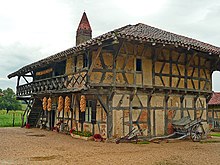A Bresse house[1] (French: ferme bressane or maison bressane, German: Bressehaus) is a timber-framed house of post-and-beam construction, that is infilled with adobe bricks and is typical of the Bresse region of eastern France. A large hip roof protects the delicate masonry from rain and snow. The house is almost always oriented in a north–south direction, the roof on the north side often being lower. This configuration offers the optimum protection from the bise, a cold northerly wind typical of the region, which is deflected over the house by the low, sweeping roof on the northern gable end. The living rooms are on the south side, the main façade facing the morning sun. Usually each room has one or two outside doors, so that no space is sacrificed for passages.

The large cantilevered roof is supported on corbels or buttresses, the eaves being further supported on a second set of shorter rafters, resulting in a double-pitched roof. The eaves enable equipment or supplies to be stored around the outside of the house and kept dry. They also enable corn cobs to be hung from the rafters to dry out.
The countryside of the Bresse is characterized by agricultural buildings; the villages often suffer from overdevelopment; the farmsteads are usually far from these villages, by lakes, streams, woods and where possible on slight eminences.

- ^ Monmarché, Georges (1949). France, Les Guides Bleu, English series, Nagel, p. 170.
© MMXXIII Rich X Search. We shall prevail. All rights reserved. Rich X Search
